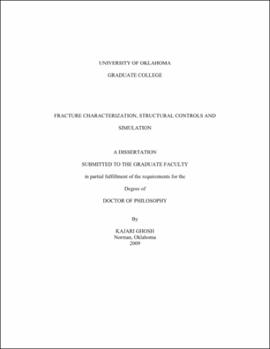| dc.contributor.advisor | Mitra, Shanakar | |
| dc.creator | Ghosh, Kajari | |
| dc.date.accessioned | 2019-04-27T21:36:34Z | |
| dc.date.available | 2019-04-27T21:36:34Z | |
| dc.date.issued | 2009 | |
| dc.identifier | 99340811102042 | |
| dc.identifier.uri | https://hdl.handle.net/11244/319148 | |
| dc.description.abstract | Fracture network patterns have been studied in two areas with different structural settings: (a) Dolomitic limestones on Teton anticline, in the frontal part of the fold thrust belt in the Sawtooth Range, Montana and (b) Cedar Mesa sandstones within normal faulted structures in the Canyonlands area, Utah. GIS-based techniques were used to study the two-dimensional distribution of fractures on exposed bedding planes in both areas. Individual fracture characteristics, such as fracture length, orientation, and density were analyzed along with the connectivity pattern of fracture networks. The latter parameter is important in determining whether the fractures are isolated or form extensive connected pathways. | |
| dc.description.abstract | Studies on both structures reveal that the fracture patterns vary with structural position. In the Teton anticline, which is a multiple hinge anticline, the longitudinal fractures represent the dominant fracture set, and show the most variation with structural position, with values greater at the hinges than on the limbs. Transverse fractures, on the other hand, show less variation with structural position and show higher densities in the vicinity of regional fractures. A method of fracture simulation which incorporates the structural controls on fracture densities was developed and applied to the Teton anticline. In the Canyonlands area, the higher density of fault-parallel fractures is observed within a narrow zone in the vicinity of normal faults. | |
| dc.description.abstract | Fracture permeability is strongly controlled by the connectivity of fractures. The connectivity of a fracture network depends on the geometry and characteristics of individual fractures and also on how the fracture sets are distributed in space. Increasing fracture propagation leads to the formation of clusters or connected fractures. The connected clusters increase in size as (1) an increasing number of fractures are added to the system, (2) the lengths of the fractures increase to connect individual fractures, (3) the orientations of fractures in a set exhibit a higher degree of dispersion, or (4) fractures of multiple sets are added to the system. A series of fracture simulations were modeled to investigate the influence of the four characteristics on the fracture network, and to identify the relative contribution of each factor towards network connectivity. Fracture clustering was also studied for both the Teton anticline and the Canyonlands area, and found to be strongly controlled by structural position. | |
| dc.format.extent | 222 pages | |
| dc.format.medium | application.pdf | |
| dc.language | en_US | |
| dc.relation.requires | Adobe Acrobat Reader | |
| dc.subject | Fracture mechanics--Montana--Teton County | |
| dc.subject | Geology, Structural--Montana--Teton County | |
| dc.subject | Fracture mechanics--Utah--Canyonlands National Park | |
| dc.subject | Geology, Structural--Utah--Canyonlands National Park | |
| dc.title | Fracture characterization, structural controls and simulation | |
| dc.type | text | |
| dc.type | document | |
| dc.thesis.degree | Ph.D. | |
| ou.group | Mewbourne College of Earth and Energy::ConocoPhillips School of Geology and Geophysics | |
